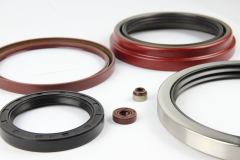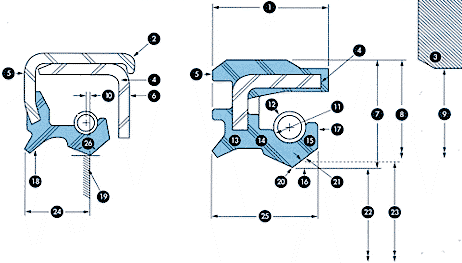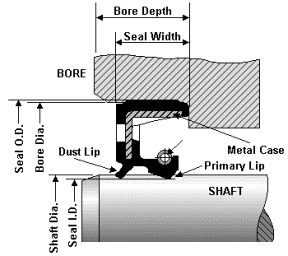 The Rotary Shaft Seal also known as an oil seal, shaft seal, lip seal, is a simple device for excluding dust, dirt, water or any other contaminant whilst retaining lubricant in rotary shaft equipment. Generally it has been developed as a means of protecting the bearings of rotating shafts.
The Rotary Shaft Seal also known as an oil seal, shaft seal, lip seal, is a simple device for excluding dust, dirt, water or any other contaminant whilst retaining lubricant in rotary shaft equipment. Generally it has been developed as a means of protecting the bearings of rotating shafts.
The Flexible Lip is held against the rotating part (usually the shaft) whilst the casing (or O.D) is pressed into the housing bore and holds the seal in place.
Oil seals prevent internal system fluids from leaking and keep external contaminants from entering the system. Leakage and/ or contaminants paths occur between the shaft and the seal lip (ID) and between the seal and the housing (OD). Oil seals should seal both dynamically (ID) and statically (OD).
Dynamic sealing is the relationship between the shaft and the sealing element. The sealing element or lip may include a garter spring, which increases the radial interference between the seal lip and the shaft.
Static sealing is the relationship between the stationary housing and the seal OD. It is the interference (press fit) between the larger OD of the seal, and the bore which results in the static seal. Using an elastomeric OD over a metal OD will improve the static sealability.
An oil seal normally consists of three basic components: the sealing element, the metal case and the spring. The purpose of the sealing element is to stop the fluid from leaking between the shaft and housing. The metal case will give rigidity and strength to the seal while it is being held in the bore or recessed groove. The spring will help make the sealing element more effective.
Materials which are available?
Leather is the oldest of the lip materials still in use with an increase in Synthetic Rubbers.
Nitrile is very popular too and Viton® for high temperature and chemical applications.
Metal Cased seals are available for metal to metal mounting and tighter housings.
Most Oil Seals are designed to accomodate 0.5 bar pressure but P.T.F.E lips can give sealing to 10 bar pressure.
For certain applications, split seals avoid the need to demount heavy and difficult machinery.
Oil Seal Selection:
|
Body Symbols |
A2 |
B2 |
B |
BR |
C |
|
Lip Symbols |
|
Metal O.D. design with an inner case for greater structural rigidity |
Most standardized and economical metal O.D. design |
Metal O.D. design with fluid side rubber covered |
Part rubber/part metal O.D. design for greater O.D. sealing ability |
Rubber O.D. design for excellent O.D. sealing ability |
|
S |
SA2
 |
SB2
 |
SB
 |
SBR
 |
SC
 |
|
General nonpressure fluid sealing applications and severe grease sealing conditions |
|
T |
TA2
 |
TB2
 |
TB
 |
TBR
 |
TC
 |
|
General nonpressure fluid sealing applications and severe grease sealing conditions with light duty exclusion of foreign materials |
|
V |
VA2
 |
VB2
 |
VB
 |
VBR
 |
VC
 |
|
Economical design for grease retention or sealing viscous fluid |
|
K |
KA2
 |
KB2
 |
KB
 |
KBR
 |
KC
 |
|
Economical design for grease retention or sealing viscous fluid with light duty exclusion of foreign materials |
|
WP |
|
|
WPB
 |
|
WPC
 |
|
Dust wiper or scraper for hydraulic or pneumatic cylinder applications |
Requesting the Right Seal
|
To request a REPLACEMENT SEAL
you must know: |
To request a seal for a SPECIFIC APPLICATION
you must know: |
|
Type: |
Single Lip, Double Lip, W/Dust Wiper |
S |
Speed of shaft |
|
|
Spring Loaded? |
T |
Temperature |
|
|
Metal or Rubber OD |
A |
Application |
|
Size: |
Shaft / Bore / Width |
M |
Media being sealed |
|
|
Inch or Metric |
P |
Pressure |
|
Material: |
Nitrile, Fluorocarbon, etc |
S |
Sizes of surface conditions |
RADIAL SHAFT SEAL NOMENCLATURE
|

|
|
1) Seal Width
2) Metal Case (Outer)
3) Housing
4) Inner Case
5) Outer Face
6) Inside Face
7) Radial Wall
8) Seal Outer Diameter
9) Housing Bore Diameter
10) Spring Position (R-Value)
11) Spring Groove
12) Garter Spring
13) Heel Section |
14) Flex Section
15) Spring Retainer Lip
16) Inside Lip Angle
17) Toe Face
18) Auxiliary (Dust) Lip
19) Rib (Helix)
20) Contact Point
21) Inside Lip Surface
22) Spring Set Lip Diameter
23) Free Lip (Unsprung) Diameter
24) Contact Line Height
25) Lip Height
26) Lip Angle |
DIMENSIONING A SEAL

If you require further information or enquire, please contact us. Simply call us on: +8620 36013580, or e-mail us: sales@dkirubber.com.

